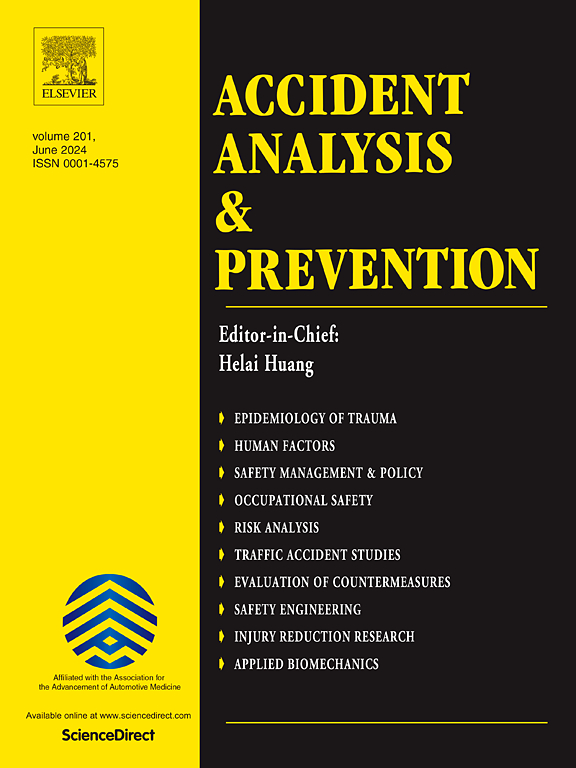利用多类型交通冲突的双变量贝叶斯分层极值模型对高速公路水平曲线上的碰撞事故进行估计
IF 6.2
1区 工程技术
Q1 ERGONOMICS
引用次数: 0
摘要
高速公路水平弯道由于道路线形欠佳,视觉条件差,对驾驶动作要求较高,对车辆行驶安全性提出了很大的挑战。多辆碰撞车辆之间的相互作用可能产生具有相关性的多类型碰撞风险。单独对不同类型的碰撞风险进行建模将导致有偏差的碰撞估计。本文提出了一种二元贝叶斯层次极值建模方法,该方法由二元极值模型和贝叶斯层次结构组成。前者综合了两种不同的冲突指标,同时也考虑了它们的相关性。后者结合了不同站点之间的流量冲突,结合了块级和站点级协变量以及未观察到的异质性。利用银昆高速公路14个方向弯曲路段的追尾和变道冲突数据,构建了单变量贝叶斯层次极值模型(UBHMS)和双变量贝叶斯层次极值模型(BBHMS),对追尾和侧碰撞进行了预测。碰撞估计结果表明,考虑多类型冲突相关性的二元模型具有较小的模型参数标准差,在碰撞估计的准确度和精度上都优于单变量模型。协变量分析表明,较大的大型车辆比例和车速标准差将导致追尾和侧面碰撞风险增加;随车车辆数量和变道车辆数量分别对追尾和侧面碰撞风险有正向影响,而超速和车道空间占用越高反而会降低追尾碰撞风险。当垂直曲线与水平曲线重叠时,凹陷垂直曲线的追尾和侧面碰撞风险大于波峰垂直曲线。本文章由计算机程序翻译,如有差异,请以英文原文为准。
Bivariate Bayesian hierarchical extreme value modeling using multi-type traffic conflict for crash estimation on freeway horizontal curves
Freeway horizontal curves pose great challenges to vehicle driving safety due to suboptimal road alignment, poor visual conditions, and higher demands for driving maneuvers. The interaction between multiple conflicting vehicles may generate multi-type crash risks with correlations. Modeling individual types of crash risks separately will result in biased crash estimation. In this study, a bivariate Bayesian hierarchical extreme value modeling approach, which consists of a bivariate extreme value model and a Bayesian hierarchical structure, is developed. The former integrates two different conflict indicators while also accounting for their correlation. The latter combines traffic conflicts across different sites, incorporating block-level and site-level covariates and unobserved heterogeneity. Using rear-end and lane-changing conflicts collected from 14 directional curved segments of the Yinkun freeway, several univariate Bayesian hierarchical extreme value models (UBHMS) and bivariate Bayesian hierarchical extreme value models (BBHMS) were constructed to estimate expected rear-end crashes and side crashes. The crash estimation results show that the bivariate model considering correlation between multi-type conflicts has smaller standard deviations of the model parameters and outperforms the univariate models in both accuracy and precision of crash estimation. The covariate analysis suggests that a larger proportion of large vehicles and standard deviation of speed will lead to an increase in both rear-end and side crash risks; the number of car-following vehicles and the number of lane-changing vehicles have positive influences on rear-end and side crash risks, respectively, whereas the higher the overspeed and the lane space occupancy instead reduce rear-end crash risk. Finally, when vertical curves overlap with horizontal curves, the rear-end and side crash risks on sag vertical curves exceed those on crest vertical curves.
求助全文
通过发布文献求助,成功后即可免费获取论文全文。
去求助
来源期刊

Accident; analysis and prevention
Multiple-
CiteScore
11.90
自引率
16.90%
发文量
264
审稿时长
48 days
期刊介绍:
Accident Analysis & Prevention provides wide coverage of the general areas relating to accidental injury and damage, including the pre-injury and immediate post-injury phases. Published papers deal with medical, legal, economic, educational, behavioral, theoretical or empirical aspects of transportation accidents, as well as with accidents at other sites. Selected topics within the scope of the Journal may include: studies of human, environmental and vehicular factors influencing the occurrence, type and severity of accidents and injury; the design, implementation and evaluation of countermeasures; biomechanics of impact and human tolerance limits to injury; modelling and statistical analysis of accident data; policy, planning and decision-making in safety.
 求助内容:
求助内容: 应助结果提醒方式:
应助结果提醒方式:


